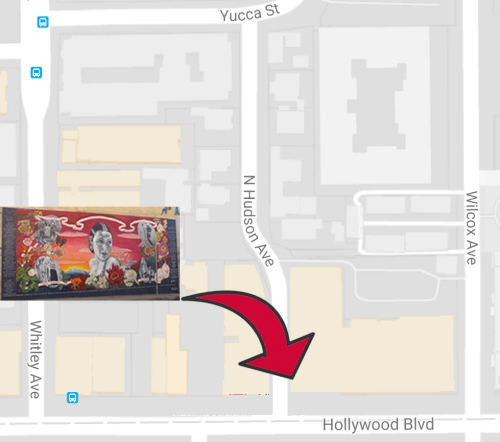If you find yourself wandering around Hollywood, you might come across this:

…located here:

It’s a tribute to actress Dolores del Río:
…who, in the 1920s, was the first major Hollywood movie star from Mexico.
She became a film actress at the age of 21 when she and her first husband, Jamie del Río, moved to California with Hollywood Ambitions. Her début, Joanna (1925), was a box office hit and earned del Río the sobriquet “the female Valentino”. She was a success in both silent and sound films, although sound proved especially challenging. “I had to work very, very hard at my English¹,” she said.
But hard work never seemed to deter del Río. According to Wikipedia, “Critics said [she] could speak and sing in English with a charming accent. She was a suitable star for the talkies.”²
We all know how important it is to be Suitable, and this allowed del Río to sign a contract with RKO. She strove to make her film characters truly interesting women, while railing against the Latina stereotypes we still see today. She insisted her Hollywood bio identify her as Mexican, not Spanish. As she put it:
I…am eager to play in stories concerning my native people… It is my dearest wish to make fans realize their real beauty, their wonder, their greatness as a people. The vast majority seem to regard Mexicans as a race of bandits, or laborers, dirty, unkempt, and uneducated. My ambition is to show the best that’s in my nation.³
Meanwhile, the press scrutinized her personal life, including allegations she was a communist and her four-year affair with Orson Welles that ended her marriage to MGM art director Cedric Gibbons.
Her Hollywood career faltered in the late 1930s, but Mexican filmmakers lobbied for her return to Mexico. This she did in the early 1940s, after the death of her father.
I wanted to go the way of the art. Stop being a star and become an actress, and that I could only do in Mexico. I wish to choose my own stories, my own director, and camera man…. I wanted to return to Mexico, a country that was mine and I did not know.4
In Mexico, del Río would become a Legend, and not just in the movies.

del Río and Pedro Armendáriz in the 1943 drama, Flor Silvestre. Image: México Cinema
del Río’s Mexican films are still impressive. Her debut, Flor Silvestre (Wild Flower, 1943), is considered one of the most beautiful films of Mexican cinema. Her next film, Maria Candelaria (1944), won a Grand Prix at Cannes. Her third film, Las Abandonadas (The Abandoned), netted her the Silver Ariel (Mexican Oscar) for Best Actress.
In the 1950s, del Río began appearing on stage and television. Then, after 18 years – and finally being cleared of communist allegations – she was invited back to Hollywood to appear as Elvis Presley’s mother in the 1960 Western, Flaming Star.
There was something about del Río that seemed almost ethereal. As Marlene Dietrich noted, “Dolores del Río was the most beautiful woman who ever set foot in Hollywood.”5
She was more than beautiful and talented; she was also a humanitarian. Vox.com lists some of her accomplishments:
- First woman to sit on the Cannes Film Festival jury (1957).
- Co-founder of the Society for the Protection of the Artistic Treasures of Mexico.
- Helped establish Estancia Infantil Dolores del Río, a childcare centre for members of the Mexican Actors Guild.
She was also the inspiration for the 1933 novel La Estrella de Día (Star of the Day), and has been featured in numerous works of art in Mexico and the U.S. – including the mural in Hollywood.

Artist Alfredo de Batuc (left) in 2016, removing unsolicited artwork (right). Images: SPARC
The mural, created in 1990 by Alfredo de Batuc, includes the titles of del Río’s notable Hollywood and Mexican films. de Batuc even created black and white “stills” from four of those films*.
de Batuc’s mural is part of the SPARC Neighbourhood Pride Mural program. According to the SPARC website, the program’s “intent is to create and represent the various cultural identities throughout Los Angeles neighborhoods.”
When de Batuc responded to the program’s call for artists, he said he knew “the subject matter was going to be Mexican…someone who…contributed or was a prominent member of the Hollywood establishment in the past. That’s why I chose Dolores Del Río.”6
What’s this? You think del Río should have more Hollywood tributes? Well, guess what.
There’s this:
And look at this:
This is the Hollywood and La Brea Gateway, a.k.a. “The Four Ladies of Hollywood” gazebo, at the west end of Hollywood Blvd. According to Wikipedia, “[i]t was commissioned in 1993…and created by the architect…Catherine Hardwicke as a tribute to the multi-ethnic women of Hollywood.”7
The women are Anna May Wong, Dorothy Dandridge, Mae West – and look who else is here. Why, it’s Dolores del Río!
Dolores del Río was one of the many extraordinary women of the twentieth century. If you’re ever in Hollywood, be sure to visit these tributes to a remarkable actress and humanitarian.

The Dolores del Río Google Doodle from August 3, 2017.
Notes:
- A special thanks to Jason in Hollywood for the use of his photography.
- The Library of Congress listing for the mural is HERE.
- ¹IMDB: Dolores del Río quotes.
- ²Wikipedia: Dolores del Río
- ³Ibid
- 4The Mary Sue: Today’s Google Doodle Celebrates Dolores del Río, Who Still Inspires Today
- 5Wikipedia: Dolores del Río
- 6SPARC: City-Wide Mural Program, Dolores del Río
- 7Wikipedia: Hollywood Walk of Fame, Four Ladies of Hollywood
- *What Price Glory? (1926), Maria Candelaria (1944), Flying Down to Rio (1933) and The Fugitive (1947).
This is part of the #DEPELICULA Blogathon hosted by Once Upon a Screen.




















Good to see del Rio getting a bit o’ the good stuff — recognition! She really was a most extraordinarily talented performer and, as you (and Dietrich!) say, quite remarkably lovely.
I don’t think I’ve seen any of her Mexican movies, and I know I’ve seen far too few of her anglophone ones — something I must remedy when time permits.
LikeLiked by 1 person
I need to see more of her films, too. Some of her early Mexican films are on YouTube, but I haven’t yet found any with English subtitles. I’ve always been impressed by her performances. She really had the whole movie star package – talent, good looks and charisma.
LikeLike
Excellent tribute!
LikeLiked by 1 person
Thanks so much! Dolores deserves more fan love these days, no?
LikeLike
What a great piece highlighting an under-celebrated actress. I was especially by her post-Hollywood work, about which I know nothing. I can’t wait to explore that part of her career more deeply. Great piece!!
LikeLiked by 1 person
Thanks! I didn’t know much about her aprés-Hollywood work, either, only to discover that those years were only just scratching the surface.
LikeLike
I love finding out abour the post-Hollywood lives of big names. So many did very cool stuff. And, of course, so many didn’t. Thanks!
LikeLiked by 1 person
Thank you for this fine tribute.
LikeLiked by 1 person
Thanks very much! There is so much to say about Dolores. I’m sure someone must have published a biography (in English), but I’ve been unable to track it down so far.
LikeLike
Thanks for the wonderfully informative article on a true beauty and artist who inspired so many other artists.
LikeLiked by 1 person
Thanks! Researching Dolores del Río was pure pleasure – and quite inspiring, too. 🙂
LikeLike
Dolores del Rio deserved better of Hollywood. I have not seen any of her Mexican films. And was unaware of the “Four Ladies.” You are so educational!
LikeLiked by 1 person
Haha! Thanks. When I was in Hollywood, I took a bus tour of L.A. The driver pointed out the “Four Ladies” to us, among many other things. Now HE was educational!
LikeLike
I am familiar with the Four Ladies, because I make it a point to walk there before each year’s TCMFF just to breath the air surrouding the tributes to four strong, unforgettable women. But my mind boggles at the fact that I’ve yet to see the mural up close and have been to Hollywood five years in a row! NOT RIGHT!!
What a fun read, Ruth! Del Rio really was something to behold and your tribute ackowledges why she should be remembered as an important member of two classic film communities.. I adore her Mexican films and just purchased the LA OTRA DVD in Miami. Can’t wait to see it.
THANK YOU for this entry to the blogathon.
Aurora
LikeLiked by 1 person
Aurora, you must get a photo of yourself with the Dolores del Río mural next year!
Also, I like your pre-TCMFF tradition with the Four Ladies. Very cool.
Thanks for organizing this blogathon. I’ve been enjoying the wonderful entries.
LikeLike
Oooh – I LOVE this post! What a wonderful tribute to a beautiful lady. It’s amazing how much our great stars are in our daily life if we just look.
LikeLiked by 1 person
Ain’t it the truth! Classic movies/celebrities have “infiltrated” our culture more than we realize.
LikeLike
Fantastic post! I certainly learned a lot about Dolores – I didn’t know about her work as a humanitarian – and I am now willing to look for her films from the Mexican period. Bravo!
Thanks for the kind comment!
Kisses!
Le
LikeLiked by 1 person
I wasn’t aware of Dolores del Rio’s humanitarian work, either. She sounds like an utterly fascinating and determined person, doesn’t she?
LikeLike
Lovely tribute to a beautiful actress!! Though I know of Dolores del Río; am yet to see any of her movie. I ought to specially check out her Mexican films.
LikeLiked by 1 person
There are a lot of her films I need to see, too, especially her Mexican work. I’ve seen a few clips and they are beautifully filmed.
LikeLiked by 1 person
Thank you for your brief and informative piece on the legendary, and now mostly forgotten, Dolores Del Río (1904 – 1983.)
I would like to add that in spite of her being of aristocratic stock on her mother’s side of the family — the López Negrete line — she was not just another pretty face, politically she sided with the underdog, she was a staunch supporter of union rights, PEACE among nations and human rights.
After she left Hollywood she was instrumental in the formation of the Mexican actors union, and in 1950, at the height of the HUAC witchhunt, she, along many world intellectuals and celebrities, signed the Stockholm Initiative which called for an absolute ban on nuclear weapons. Her signing it won her the enmity of the US Military Industrial Complex and made her lose lucrative roles in Hollywood, such as the guest star role in “High Noon” (1952.)
Besides her film work in Hollywood and México she also graced the big screens of Argentina, Italy and the UK.
Finally I thank you for including my mural in your homage piece to Dolores Del Río.
Alfredo de Batuc
LikeLiked by 1 person
Thank you, Mr. de Batuc, for sharing more of Dolores del Río’s story. As you pointed out, she was a remarkable, inspirational woman, not to mention a talented actress.
When I first saw your mural, I gasped out loud because it is so beautiful and so cleverly done.
Thank you for stopping by.
LikeLike